The new Rio will reach Russian dealers this summer. The model will be available with two motors. What is the new Rio on the move and how is it fundamentally different from Solaris?
If "to coarsen", then the new Russian Rio sedan- this is a Chinese Verna with a front end from a European hatchback Rio. But - with a different chassis setup and many small changes that are not visible to the eye.
I'm a happy person. Because one of the first trains on Rio fourth generation(with the factory index FB), the assembly of which has just begun at the plant in St. Petersburg. For the sake of this, I had to fly to St. Petersburg and put up with the fact that so far only camouflaged cars are allowed to drive on public roads.
It is hardly possible to take my assessments for the truth in last resort. I rode nothing at all, the new cars were from a pre-production batch (one with a mileage of about 50 thousand kilometers), and the camouflage, in addition to hiding the contours of the body, also creates a noticeable background noise at high speed. Nevertheless, there are some observations - especially since we managed to jump from the old Rio to the new one and back. 
 In terms of interior quality, Rio rises to one of the highest levels among cars "up to a million and a little more expensive." It's good that the front panel is devoid of dubious Asian lines - everything is strictly European.
In terms of interior quality, Rio rises to one of the highest levels among cars "up to a million and a little more expensive." It's good that the front panel is devoid of dubious Asian lines - everything is strictly European. 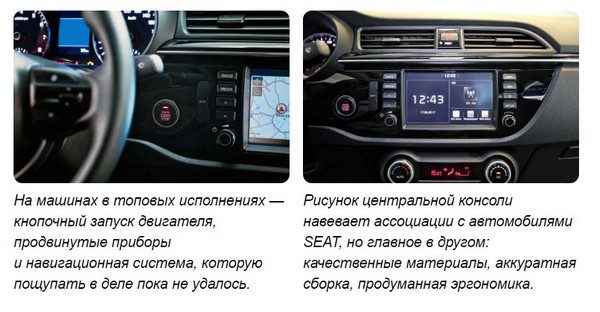
Has the character of the new generation Kia Rio changed?
So, the main question is: has the character changed? new Rio? The answer is unequivocal: yes! Reconfigured electric power steering, new geometry of the front suspension (in particular, the angle of inclination of the axis of rotation of the wheel is increased by half a degree) and modernized rear suspension, in which the shock absorbers stood almost vertically, did their job. If the old Rio rides just with dignity, then the new one has a lively thing that will clearly please active drivers. The beginner feels better “on the steering wheel”, more confidently holds the high-speed straight line and is more willing to rebuild after the turns of the steering wheel. Damn it, there have never been such revelations for inexpensive Kia before! 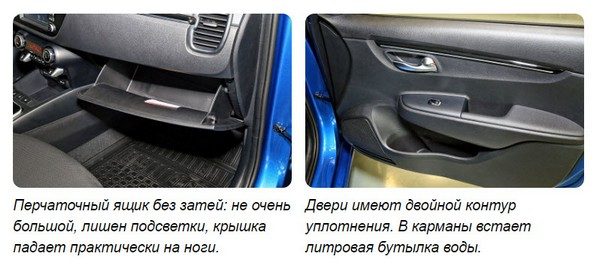
But I will not overpraise, because not everything is clear. Firstly, it seemed to me that in the limit turns Rio too willingly falls into a skid, noticeably squatting on a loaded rear wheel. But this has yet to be retested on commercial vehicles. In addition, three more people from the factory were traveling with me, so the load was noticeable.
You have to pay for excitement, and you know what - smoothness. The new Rio is slightly stiffer, the steering wheel has a slight itch (its echoes are also noticeable on the pedals), the noise level from the road has slightly increased. Is it bad? Decide for yourself. For me, a better understanding in the car is more important than a slight loss in comfort. 
Kia folks say potential buyers particularly like the T-arm automatic box on which the hand rests comfortably. The seat heating buttons are located in front of the selector - not the best solution.
And it's good that the 6-speed automatic was reconfigured. The Koreans say that this is a new generation box, although it is more correct to talk about modernization. On the old Rio 1.6, with more or less active driving, the gas pedal has only two positions: either the entire working stroke, when practically nothing happens, or the “almost to the floor” position, when the machine suddenly wakes up and convulsively tucks downshift. Nervous, tattered ride. And on a new car, this dependence is more linear: if you push, you accelerate. I pressed harder - the box went one step lower, the car went even faster. More convenient, clearer, more comfortable and ultimately safer. 
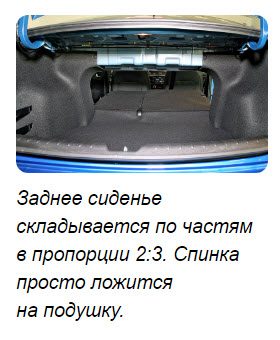 If we are already talking about units, it's time to recall that the new Rio is practically the twin brother of Solaris. Therefore, the engines are the same: 1.4 liters (100 hp and 132 N∙m) and 1.6 liters (123 hp and 156 N∙m). Both motors will be combined with a 6-speed manual and a 6-speed automatic. My choice - 1.6 with a "handle": a great pair!
If we are already talking about units, it's time to recall that the new Rio is practically the twin brother of Solaris. Therefore, the engines are the same: 1.4 liters (100 hp and 132 N∙m) and 1.6 liters (123 hp and 156 N∙m). Both motors will be combined with a 6-speed manual and a 6-speed automatic. My choice - 1.6 with a "handle": a great pair!
Factory people assure that the car has noticeably increased in size, but this is not entirely true. Who will notice an increase of 23 mm in length? It can be reached with other bumpers. By the way, Rio is shorter than the new Solaris by 5 mm, although technically the cars are extremely similar. Why? I'm talking about bumpers.
Current Auto News
The wheelbase has grown by 30 mm - up to 2600 mm. Now this is more serious. But here it is necessary to return again to Solaris, which has the same wheelbase- and how can it be different if the "cart" is the same? 
The proportions of the body have changed: the hood is now visually much longer than the trunk. The image has become more solid. I put the top 16-inch wheels in credit. Equipped with caps, 15-inch “stampings” look an order of magnitude more modest.
 Claimed clearance - decent for this class 160 mm. I did not check it, because the cars that were at my disposal were unprotected engine compartment, and it is she who, as a rule, determines the lowest point. Here we take a commodity car a little later and deal with this issue in detail.
Claimed clearance - decent for this class 160 mm. I did not check it, because the cars that were at my disposal were unprotected engine compartment, and it is she who, as a rule, determines the lowest point. Here we take a commodity car a little later and deal with this issue in detail.
Of the other important decisions for our motorists, I will note the increased to 50 liters (+7 l) fuel tank. The washer reservoir has also become more capacious: before it was 4-liter, and now its volume is 4.6 liters. This is a small victory, but why was it not immediately brought to 5 liters so that the contents of a standard canister could fit into the tank?
AT engine compartment everything is organized extremely neatly and thoughtfully: easy access to battery, to the washer fluid reservoir neck and to the oil plug. Even the bulbs in the headlights are convenient to change - I checked. 
Atmospheric "fours" 1.4 (100 hp) and 1.6 (123 hp) are powered by 92-m gasoline and are equipped with phase shifters both at the intake and at the outlet.
Did you notice that I didn't say a word about the design? There will be a lot of disputes (some will like it, others will not), and I do not want to act as an arbitrator. I can only say that all the spy photos that have flashed on the Internet so far can be forgotten: our car has its own front bumper - it turned out to be such a combination Chinese sedan Kia K2 with bumpers from the European hatchback Rio. Although this is not a completely accurate description! Our Rio was created specifically for the Russian market, and many components and individual parts were brought to our requirements. If the brake disc has similar dimensions but different specifications, is it the same part? As an engineer, my answer is no.
Live Rio looks more interesting than in the photographs. The decision to visually combine the taillights seems to me extremely successful. Yes, and "boomerangs" in the bumpers are quite appropriate. And the interior is really good! The new Rio blurs the line between B and C class cars: the quality of the finish will be envied by others expensive cars. And it's good that the Koreans finally left the dubious Asian lines: moderate European rigor suits the car.
Although it was not without oddities. For example, the Koreans sacredly keep the custom of placing “pullers” of the gas tank hatch and trunk locks at the driver’s feet. Come on, there must be something family. 
External dimensions (mm). The dimensions are as close as possible to the segment C2 (C).
Rio equipment is rich. It is clear that there are airbags, a dynamic stabilization system, air conditioning (or climate control), power windows, heated exterior mirrors, two-stage rear seat heating, a tire pressure monitoring system and ERA-GLONASS. But that is not all. Rio can be equipped with a multimedia system with a 7-inch screen that supports Apple CarPlay and Android Auto (navigation builds routes based on traffic jams), there is a rear-view camera and even cornering side lights. And among the special chips is a leather interior, which Solaris does not have. It is clear that this is the so-called eco-leather (we simply call it leatherette), but some will want this. I prefer fabric seats - they are more comfortable and pleasant, even in the heat, even in the cold.
Kia Rio 2017 price in Russia
At the beginning of my story, I apparently got excited about the "main question." Intelligible handling is great, but not everyone is touched by it for the living. But the price is of interest to everyone. And there is still a lot of uncertainty on this issue. 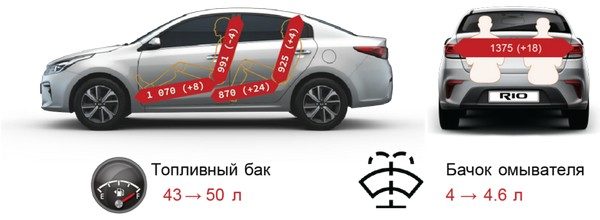
Internal dimensions (mm). Even more space for passengers and more!
The Koreans say that sales will begin in the third quarter of this year. And the third quarter - here it is, knocking on the door. July? August? September? So far, silent (although August looks like the most likely solution). About the prices - especially not a word. But you don't have to be a visionary to predict with 99.9% accuracy what Rio price not far away from Solaris, prices for which range from 625 thousand rubles to a million with a small tail, if we consider a fully packed car. 
The share of Kia Rio in the C1 (B+) segment is constantly growing.
Will there be a Kia Rio crossover?
And a few more words for those who drive crossovers or still only dream of all-wheel drive. All the talk about small crossover Kia we can safely turn it off - we will not have one in the near future. A facelifted Creta with Kia emblems will only damage the brand, as everyone will perceive such a car as a secondary one. And it’s not a fact that now in our market there is a place for two identical crossovers: you can sell Creta in large quantities, but two identical cars will not find twice as many customers - internal cannibalism is inevitable, which the Koreans do not want. 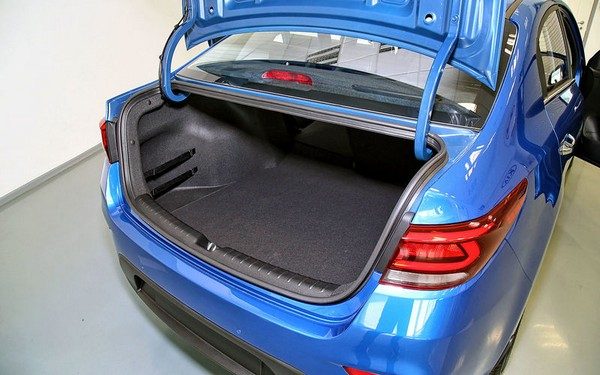
Trunk volume has decreased slightly (no exact data yet), because rear shock absorbers stand almost vertically and protrude more into the cabin. On the left wall there is a pocket for a canister with oil or a washer. 
Moreover, the capacity of the plant is limited - it is already working to its fullest: five days a week, three shifts. This is the most efficient auto production in the country, but its capacities have been almost completely selected. Kia can only make about 100,000 cars a year here - and the question is how to distribute this volume among different models. produce two completely different cars in this scenario is economically unprofitable.
Do you understand what I mean? In addition to the sedan, in a few months the Rio hatchback will appear on the conveyor, which, if everything goes according to plan, will be offered in a raised “crossover” version. Together, the sedan and hatchback will select the entire production quota. What next… 
Linked taillights in the new Kia branding. Chromed door handles (privilege expensive cars) look ugly. But, as they say, many buyers like this option.
Then everything will depend on you, dear readers. You are not only readers, but also buyers! If in the foreseeable future, along with the growth of the market (and there has been one), sales Kia cars in Russia will rise to at least 200 thousand a year, the Koreans will have a serious reason to think about building a new plant, since there is a site near the existing Hyundai enterprise - it was originally envisaged. Go ahead. Maybe the new Rio will help.
Became the best-selling car in the Russian market. True, this is the success of the previous generation model. Will the new Rio, which re-enters the market later than the Solaris platform, hold it back?
Colleagues say that the design Rio is better than Hyundai, but, in my opinion, it is too pretentious: stretched almost to windshield headlights, oversported bumpers… The trunk lid lost its license plate, and with it the sympathy of the taxi drivers who lifted it in the forbidden parking zone.

Salon Rio is modern and stylish. The plastic is hard, but it looks expensive, the steering wheel is comfortable, the instruments are cool, in the top version there is a large touch screen, which is located lower than that of Solaris and therefore it is a little less convenient to use it. The Kia chairs seemed too soft to me, in addition, their leatherette upholstery (such as Premium) alerted me: in the heat you will probably stick to this.

In Rio with mechanics, with a height of 176 cm, I could not sit comfortably. If I tune in on the steering wheel, then I don’t reach the pedals, in any case, I barely choose the long clutch travel, and if the pedals are just right, I almost rest against the steering wheel with my chest.
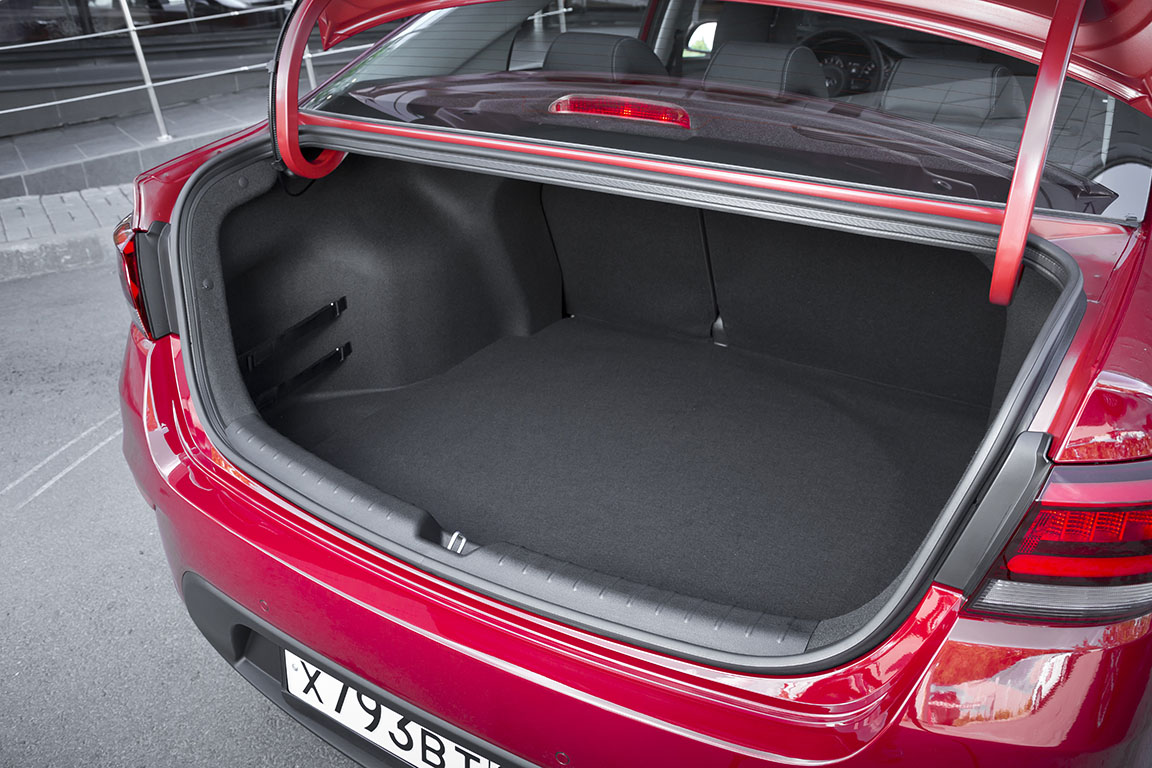
The trunk volume is actually the same - 480 liters, but the opening here is wider than the Solaris one, so it’s more convenient to load things at least a little, but more convenient. The top version even has a function of contactless opening of the compartment, but unfinished: the lid only rises slightly, forcing you to help it with your hands.

Before meeting with Rio, I specifically traveled on the new Solaris and now I am sure that the Kia sedan, although noisy, is still quieter than the Hyundai. Kia says that having collected feedback on Solaris, they managed to supplement the sound insulation right before the start of production. True, soon these measures will be taken to Hyundai cars.

The base engine of the Rio is 1.4 (100 hp), but there were none at the presentation. And with a 1.6 engine (123 hp), a sedan, both with mechanics and with a six-speed automatic, in my opinion, is equally boring. But if you choose, I would pay 40 thousand rubles for an automatic machine: the mechanics do not give the desired dynamics.

It is interesting that if the missing cruise control is promised to the sedan in the foreseeable future (first this year it will appear on the Creta crossover), then Rio will not have it until restyling, which is three years.

The platform for Rio and Solaris is the same, but the characteristics of the springs and shock absorbers are different: Kia is like a sport, and therefore tougher. Like Hyundai, Rio is not afraid of large pits, but it shakes noticeably stronger in small and medium-sized ones. If you need comfort - be sure to compare these cars in person!
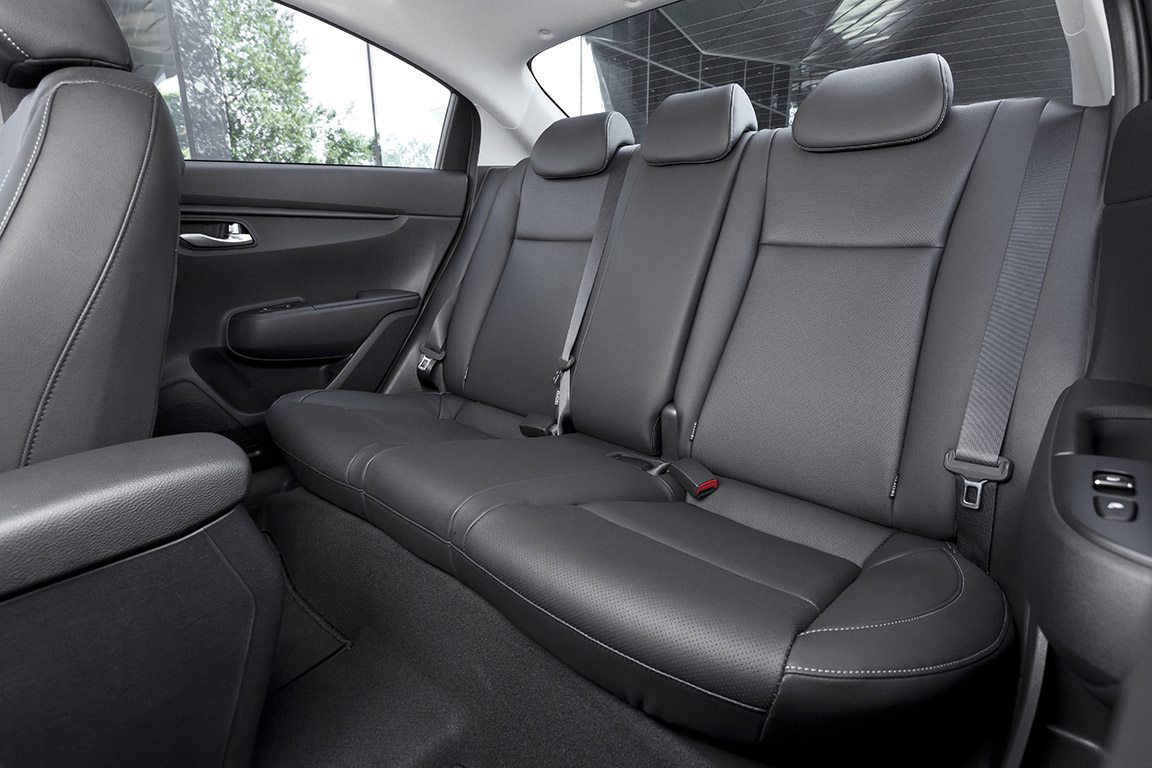
There is little sportiness in handling: the steering wheel is light, the connection with the wheels is felt, but there is no special sincerity. And if you change lanes more sharply on wet pavement - and catch a skid, fortunately, the stabilization system helps here. This is not a sport, rather nerves.

In total, Rio has nine trim levels versus four with additional packages choice from Solaris. With similar equipment, Hyundai goes 30-40 thousand more expensive than the similar Rio. Therefore, the relative alignment in terms of the popularity of models is likely to remain, but the absolute one is not a fact: after all, the new Rio is more expensive than the old one.
Many, probably with the same bated breath, as I was waiting for the new Kia Rio to arrive in Kirov. The fact that the car was expected and desired, at least says that 2-3 days after its official presentation at dealers, the new Kia Rio sold out. Even in my backyard, a couple of snow-white sedans appeared, which were an eyesore to me every morning. Well, I think we should take it. For the test, of course.
The appearance of the new sedan was not appreciated only by the lazy, so I will not focus on the shell. I can only say that the rear optics are class. Here, as with the false radiator grille, which is not even a grille at all, continuity to the family generation is visible. Yes, yes, I will also point out about it, because Kia for the first time on it worked out this story with a red stripe through the trunk lid, borrowing this idea from Japanese designers of the 90s. As for the grille, there is already a shaped resemblance to the entire Kia family. Rio, in my opinion, is the last one to stand out from the pack with its chrome-plated angular drawbar.
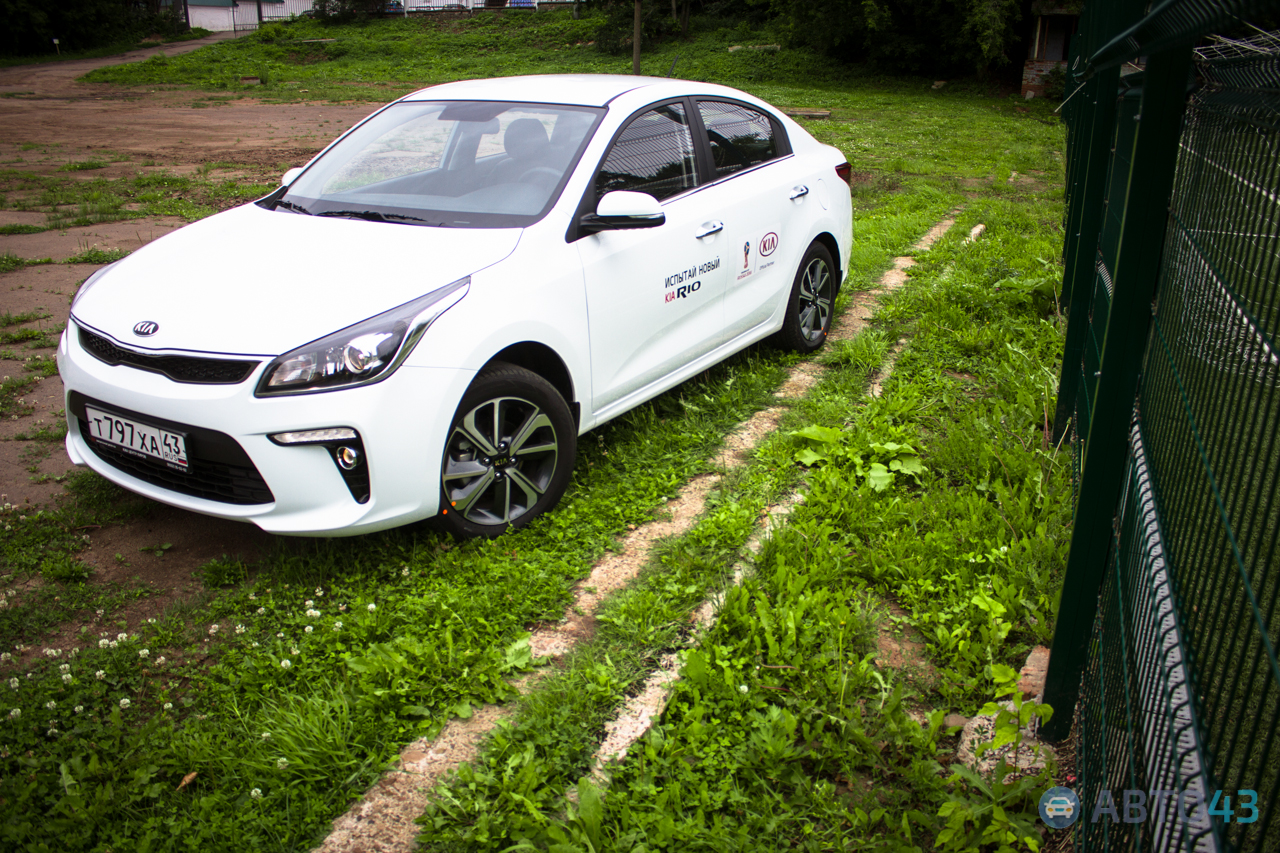
Inside, now everything is also new: dashboard, multimedia, air conditioning, materials - all this is already different, incomparable with the previous generation. Like? Highly. Much more than . In the new Rio, the multimedia installation is inscribed in the decor of the dashboard as its component, and not something isolated. The climate control also does not have bright boundaries, which is very annoying in Solaris. Silver plastic is also not used here at all, moreover, the central tunnel, the climate control unit is rubberized soft plastic. Very pleasant to the touch.

True, it was not without gloss. In general, if you look at the interior of the new Rio, you can see that the designers have played with the materials: the top of the dashboard is matte plastic, the bottom is cheap Zhiguli, in the door cards it is the same, plus soft plastic and gloss around the multimedia installation. There are also plastic, a la lacquered stained wood, inserts on the doors and on the dashboard - decor.

The steering column has been adjusted for height and reach, and the seat can be pushed back so much that your feet can't reach the pedals. In general, from the point of view of adapting the driver's seat for drivers, it turned out to be universal, for any driver.
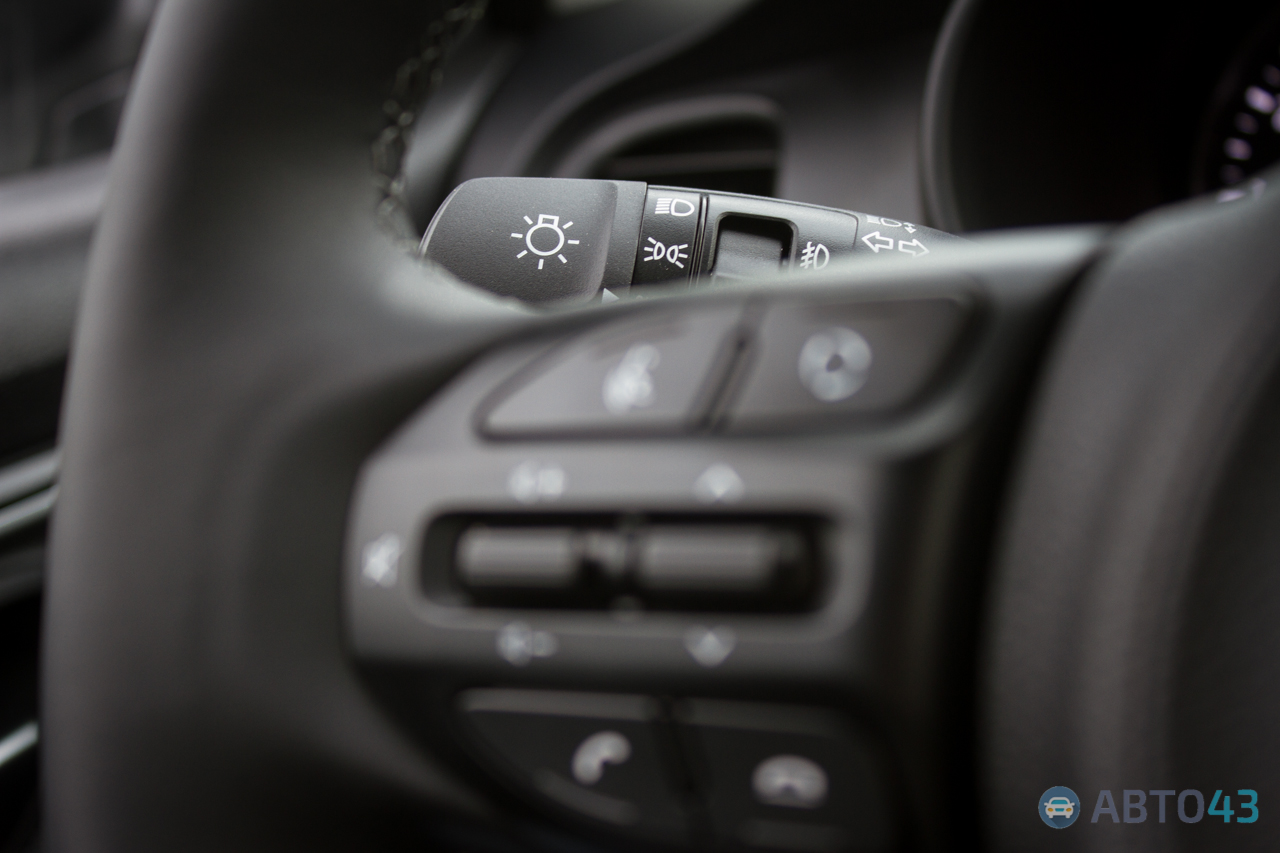
True, with the back row, everything is not so rosy. Places are objectively not enough. I tried to sit behind me and rested against the back of the front seat. And he was deeply rooted. There are no amenities on the sofa. What can I say if there is no armrest, no sockets, no air ducts. In general, the same story as on Solaris: power windows and heating of 2 seats. But the place, it seemed to me, is less than in the last one.
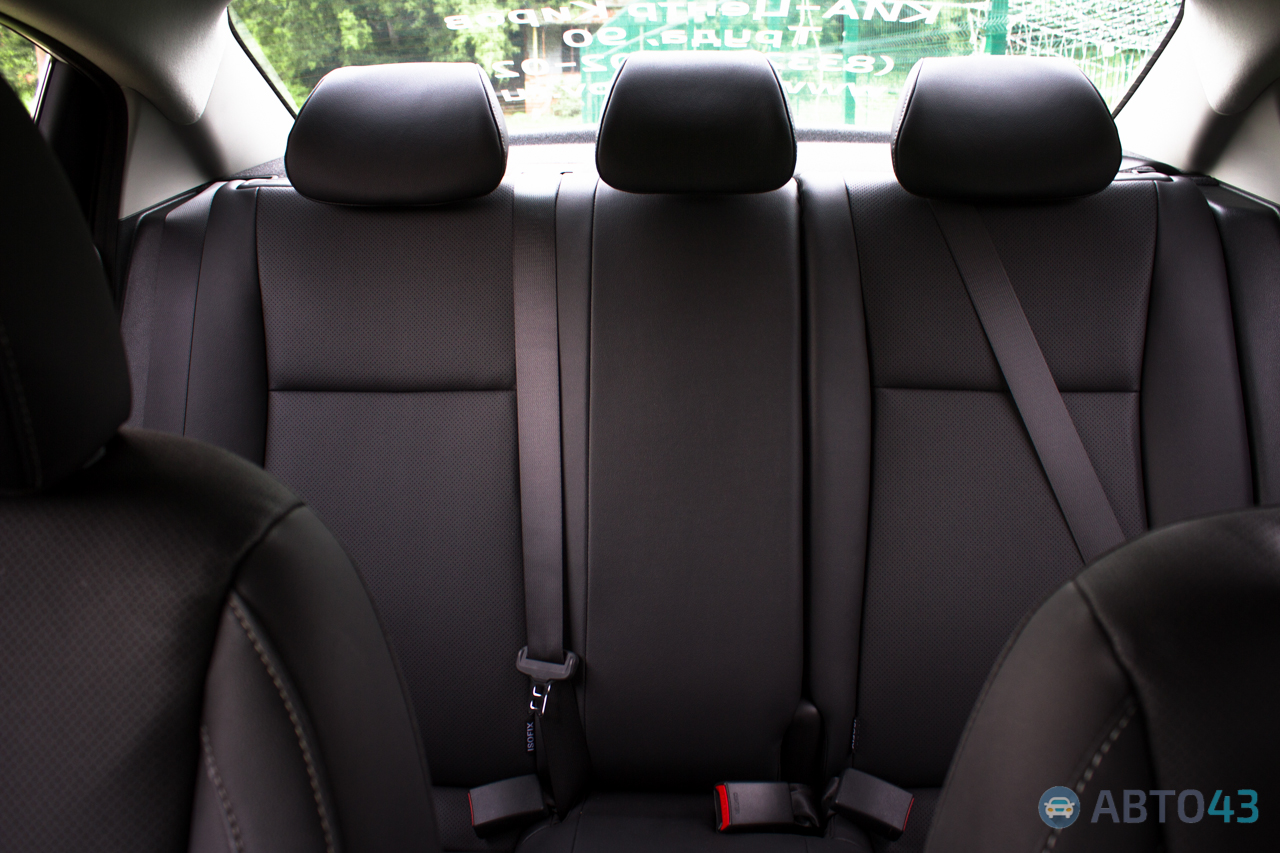
In general, if you look at Solaris and Rio, then two branches of development and imitation are actively visible. Hyundai is more committed to Japanese design and interior concepts, while Kia is more European, as evidenced by the button lighting and cabin architecture.
Despite the fact that the Korean twins have the same engine and transmission, the cars drive in a peculiar way. Kia is more restrained, calm and slow. The gas pedal here is less sensitive to pressure and has much more free play. This feature should be considered when accelerating or overtaking.
The brakes in the sedan are sharp, as, indeed, on all Kia. Out of habit at low speed, you can put your face on the steering wheel, so you need to dose the effort consciously.

During the test drive, I had to drive not only on asphalt, but also on a gravel road. What's the point of driving on smooth roads? On the gravel, although the car shook, it was felt that the suspension was trying to reduce body vibrations. It is impossible to completely avoid them, as, for example, on massive crossovers, on Rio, and the reason here is not so much in the budget of the car, but in its mass and suspension settings. If you make it even softer, then in corners at speed the car will roll a lot, and on the road when passing the same “sunbeds”, the racks will work for a breakdown. Therefore, the designers tried to find golden mean. In Solaris, by the way, the suspension works harder on small bumps, and all the vibration is given to the body, since it processes them together with the bogie.
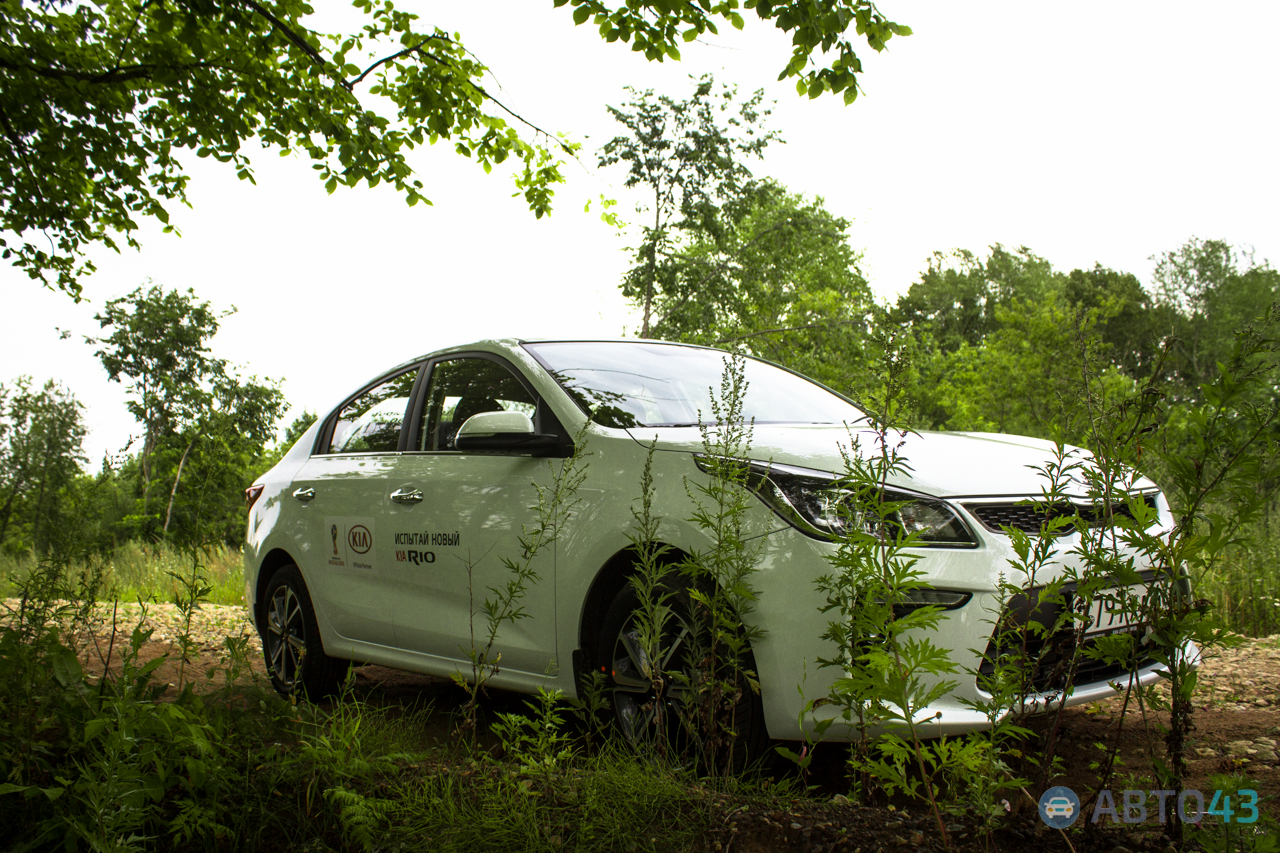
It seems to me that any person who buys a car, when choosing, relies not only on direct sensations (how it rides, how much space, and so on). It is important, being in the car, to understand that this is your car, that you are comfortable in it. So, I can’t say that driving a Kia I got some kind of sensation that would tell me “I need to take it.”
Despite the excellent interior solutions in terms of the combination of materials, the well-developed exterior, the abundance of electronic options (steering wheel heating, rear view camera, windshield heating and tire pressure sensor), Rio seemed to me personally a car that would be bought by a person who just needs a car, like means of transportation, not as a source of pleasure.
Time runs fast and relentlessly. It would seem that only recently, but in fact - two and a half years have passed! Korean bestseller, almost shared with his brother Russian market"budget" cars in half, changed the generation and is ready to continue the fight for the minds and wallets of buyers. On August 1, 2017, sales of the fourth generation of the sedan officially began. KIA Rio 2017 model year. And this beginning cannot be called anything other than a triumphant one. It's no joke - collect more than 28,000 pre-orders!
The novelty has already arrived in all more or less large dealer centers countries, and potential buyers can personally see, touch and test the new Rio on the road.
Design of the new KIA Rio 2017
Naturally, the first thing you pay attention to is the changed appearance car. With the change of generations, there was also a change in perception: the chopped and angular outlines are gone. While Hyundai Solaris, abandoning typically Asian wavy lines, headed for a more strict style of European cars (first of all - Audi), the new "Rio" is, as it were, the other way around: he peeped the design from his brother. The headlights got a more rounded and elongated shape, the false radiator grill flattened that very “tiger smile” even more - and the car's face began to look very much like the very first generation Hyundai i30 (2009 model year). The back of the car has also become smoother.
As a result, the visual style of the new "Rio" has seriously changed - enough to talk about a change of generations, and not about restyling. But at the same time, the car clearly shows its belonging to the KIA brand. Personally, only this most flattened “tiger smile” causes questions for me personally. It is clear that this is a style-forming element that should be present on every car of the brand - but this element itself cannot be called unambiguously successful, and not for every car in model range KIA it fits. On the other hand, everything is not as sad as it could be - remember, for example, Mitsubishi, forced to put the shark face of the tenth Lancer on everything - from the crumbs of Colt to the big Outlander. So, in the case of KIA, we can only say that the front of the new KIA Rio came out, albeit ambiguous, but generally pretty. Although, of course, many will prefer the severity and conciseness of the new Solaris.

However, all these “like-dislike” conversations end exactly at the moment when the “old” KIA Rio parks next to the new product. It was then, in a face-to-face comparison, that you understand how much work Peter Schreyer and his team have done, and how “old” Rio is now really perceived as old.
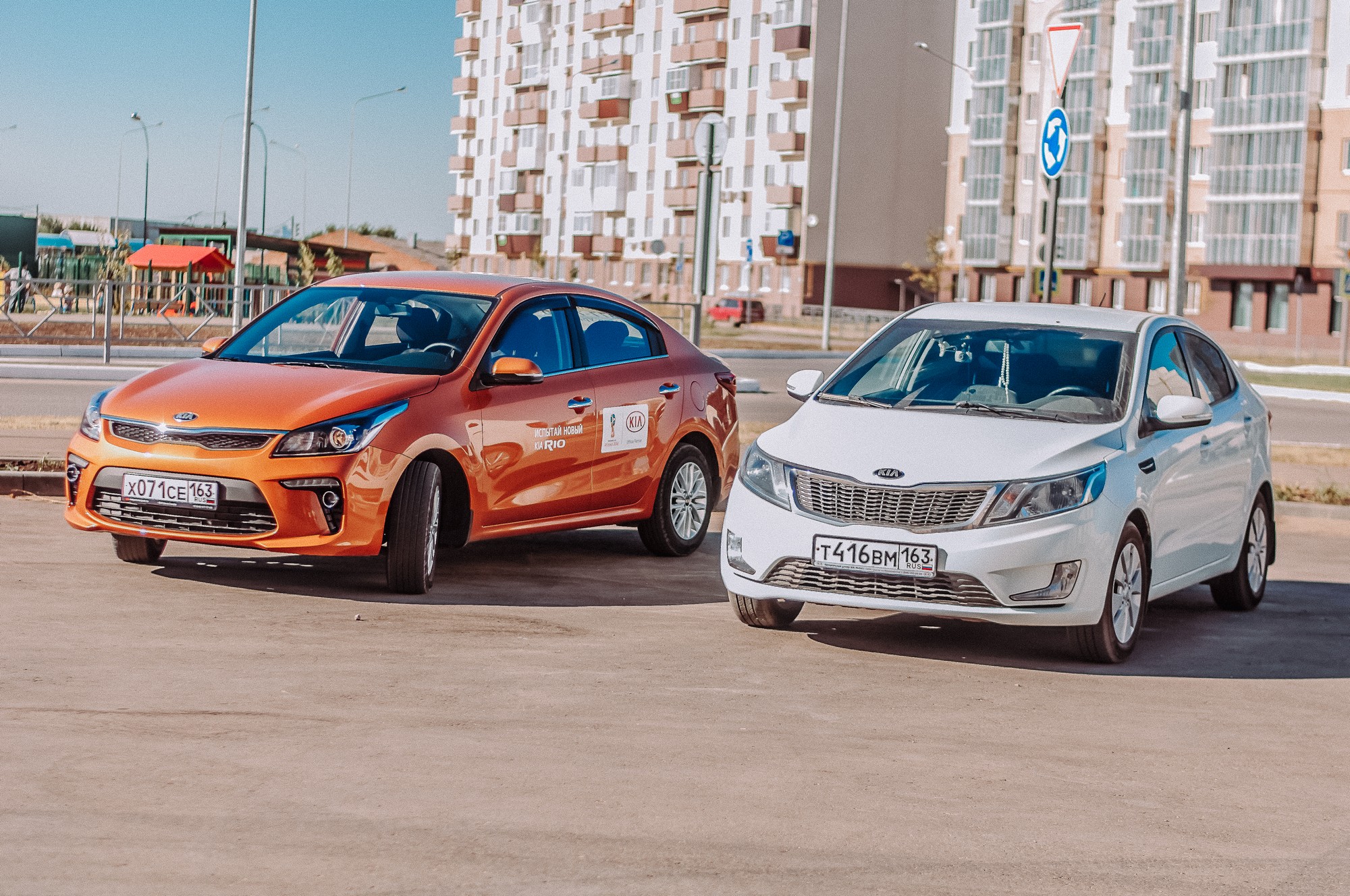
But what definitely, without any face-to-face confrontations, has become better - this is the sirloin part! To replace the huge rear lights, visually squeezing the car like a ballerina's corset, came small lights, united by a horizontal false panel. This had an extremely positive effect on the external perception of the car - the car is no longer perceived as a narrow box, despite the fact that the width has increased by only two centimeters.
Not such a small small class.
By the way, about the size. In length, the car has grown by 23 mm (up to 4380 mm), in width, as I said, by 20 mm, in height - by 15 mm. And the wheelbase has become 30 mm longer - up to 2600 mm. Cars are getting bigger every year. The current "Rio" is as much as 17 centimeters longer than the KIA Rio first generation and is equal in length to the body, for example, the first Ford Focus(and slightly larger than the first BMW 3 Series E21).

At the same time, if, again, we put models of two generations side by side, then new Kia The Rio looks to be a much wider, lower and longer car - much larger than it really is. It's like it's a different class car.
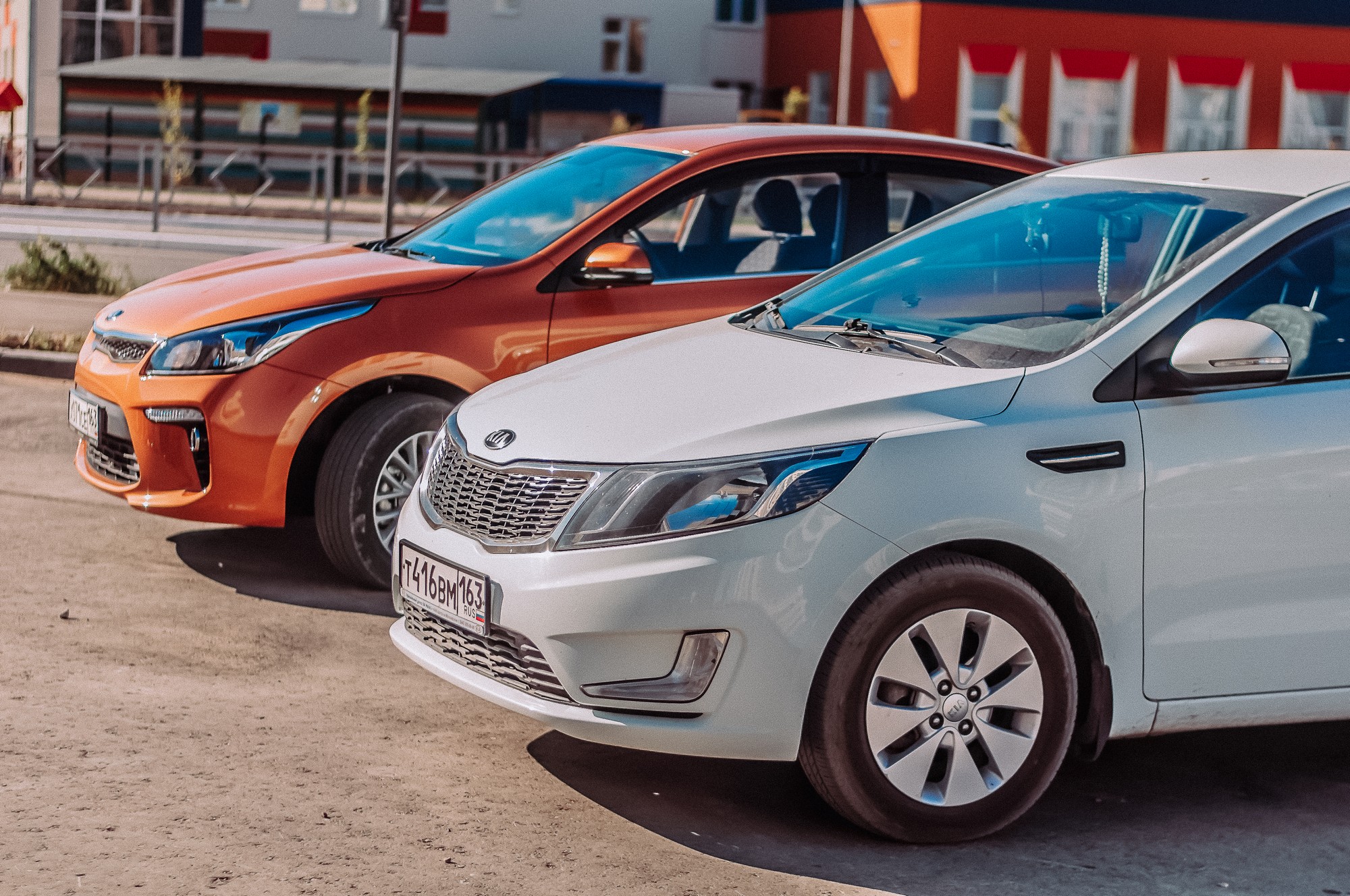
Interior KIA Rio 2017
But enough about the exterior - let's see what happened to the interior. Here the changes are no less significant. Gone are the gray plastic inserts and false carbon, the center console has acquired a seven-inch monitor and for some reason began to look very much like that in new Toyota Corolla. Control keys and knobs air conditioner grouped into a gamepad, and the gear lever became a T-shaped, with an eye on the dear (including the heart of Peter Schreyer) Germans. Finishing materials visually also began to look more expensive, eco-leather and a bunch of “luxury” options appeared in the top – right up to the rear-view camera and rear sofa heating.
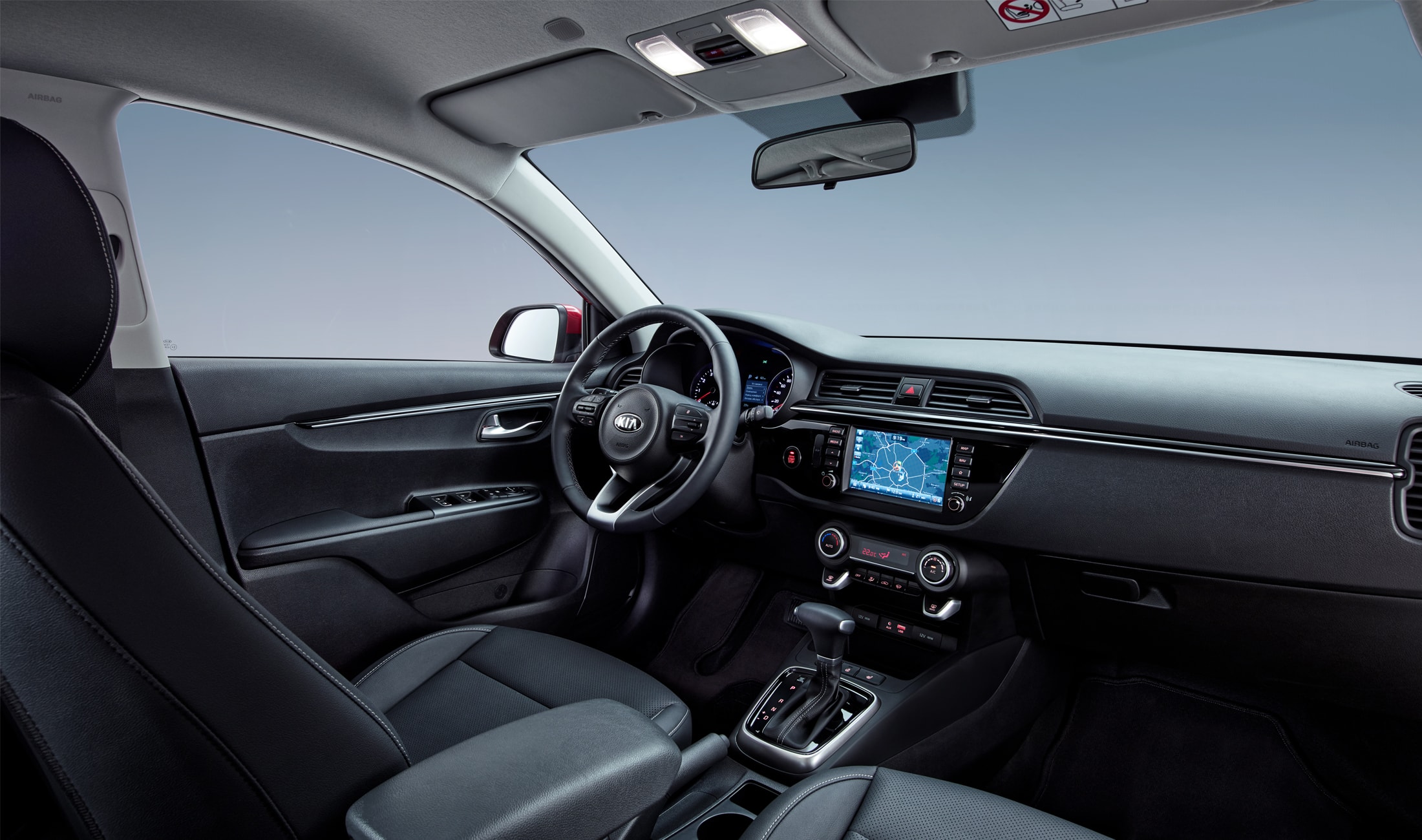
I immediately remember one of the old issues of Top Gear, the mid-2000s, in which Jeremy Clarkson tested all sorts of electronic systems top Mercedes-Benz S-Class, convincing viewers that in ten years all these options will migrate to budget cars. The new KIA Rio and Hyundai Solaris show that, on the whole, this is exactly what happened.
City test drive KIA Rio 2017
So that you understand what “in the urban conditions of Samara” means. This is a brand new blue-black asphalt sparkling in the sun - and an old, pale gray canvas with holes and potholes. These are tram lines - and a six-lane road to the exit from the city. These are narrow paths of courtyards - and the complete absence of roads in the private sector, with huge mounds and pits, along which to drive faster than 10 km / h - suicide. This is a dead traffic jam at the entrance to the bridge across the Samara River - and an empty suburban highway where 110 is possible. That is, in these few hours I managed to try the car in almost all modes in which the future owner will operate it. Unless I did not find a winter blizzard and yards uncleaned from snow. But on the other hand, I tested the climate control at plus 30 degrees.
![]()
Options KIA Rio 2017
For the test, I got a positive “ginger” in the Prestige configuration, with a 1.6-liter engine and an automatic six-speed gearbox. This is a "pre-top" equipment, costing 899,000 rubles - almost a hundred thousand cheaper than the top Premium. Why weren't we told about this difference? Firstly, the wheels of a smaller radius are fifteenth, against the sixteenth in the top. Secondly, a more modest multimedia system (without a navigator and with a monochrome display), the absence of a rear-view camera and an automatically opening trunk. Instead of eco-leather, there is a fabric interior and there is no start-stop button (as well as keyless entry systems in general). Here, in general, that's all.
In principle, we can say that this equipment is ideal in terms of price-quality ratio. I was upset only by the black-and-white multimedia display (in 2017, this is somehow completely wild) and the lack of a rear-view camera (although there are parking sensors). Otherwise, everything you need is present, and the car costs 10% cheaper than the top-end configuration.

As I said, the engine in my "saffron milk cap" was 1.6, with a capacity of 123 hp. It's the same engine. And the same "six-step", by the way. There is also a choice of a costly 1.4. This, again, is a motor from the previous generation, but programmatically deformed for the sake of tax reduction. They say that even with a junior engine, the KIA Rio drives quite quickly - but even the top-end configurations with it are noticeably poorer. There is no windshield heating, washer nozzles and rear sofa, no parking sensors and a whole bunch of "luxury" options. So, 1.6 is still wiser to buy, albeit more expensive.
How does she drive?
The dynamics of the engine are enough for the eyes, and paired with a six-speed automatic - and smoothness too. The machine goes through the gears imperceptibly, without making you wince from unexpected roars of sharp transitions to the lower ones - only the expected roars are on the menu today. Kickdown is moderately thoughtful - not so much that it annoys or creates emergencies. I personally lacked a bit of picking up the gas pedal in the middle of the stroke - when you want to accelerate slightly, but just slightly. You feel a certain failure of sensitivity (sorry for the tautology), you have to push a little harder - and the machine, dropping the gear, gives in to the gas. However, perhaps this is my personal driving style, developed over the years of driving on mechanics.
I really liked the steering wheel. I'm absolutely delighted! Firstly, it is here with an electric booster (it used to be power steering). Light, obedient, even somewhat sharp - it is a pleasure to drive a car. And secondly, just steering wheel very cool made: pleasant to the touch, with ebb under the thumbs in the correct position, the ideal thickness. This, of course, is not yet the King of All Steering Wheels - the BMW M-steering wheel - but something close enough to it.
Suspension and ground clearance
By the way, about the microvibrations that scared the entire Internet Stillavin and Vakhidov. Consider me thick-skinned and wooden, but after three hours of driving I did not feel any micro-vibrations on the steering wheel. And even more so - I did not experience any phantom vibrations in my hands after leaving Salon KIA Rio. Perhaps the whole point is after which car to get into Rio. But I didn’t notice anything criminal - even after I was reminded of this in the middle of the route and asked to specifically listen to my feelings. My opinion is that the problem (if it exists at all) is overblown.
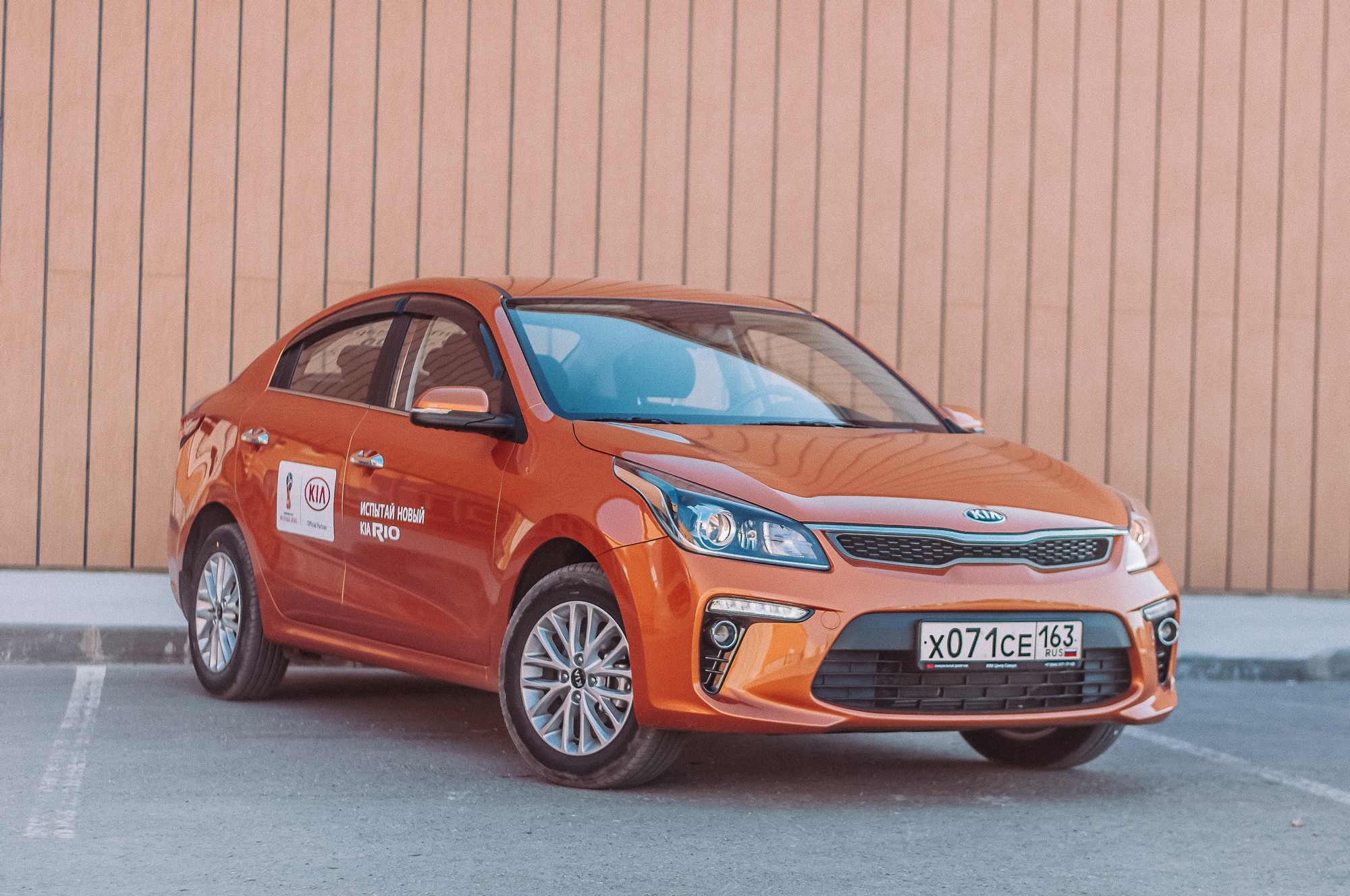
I will say a few words about the suspension. She is tough and collected. I don’t know how it is on the top sixteenth wheels, but on fifteen-inch wheels it’s comfortable to move even on imperfect asphalt. At the same time, there are no buildups on bumps - I checked it at speeds from 5 to 105 km / h. For a city car, the suspension is set up perfectly.
Moderately stiff suspension and 160 millimeters of ground clearance allow you to confidently pass in those directions where the asphalt last touched the ground twenty years ago (or did not touch at all). However, it’s also not worth imagining a crossover - the forgotten driver will quickly be reminded of this by blows to the bottom. Praise to the creators - crankcase protection is now installed at the factory.

About consumption
Average fuel consumption during the test, according to on-board computer, amounted to 12.9 l / 100 km. Quite a lot - but we managed to stand in a traffic jam, and hustle around the city, and just leave the car for Idling with working climate control. He, by the way, did not turn off and completely coped with his task of saving us from the thirty-degree heat. With one caveat - back seat nevertheless, it was noticeably hotter than in front, and in order to deliver the long-awaited coolness to the rear passenger, it was necessary to increase the intensity of the airflow. At the risk of catching a cold from the cold air currents.

Test drive KIA Rio 2017: summing up
Based on the results of such a relatively short test drive, I can say the following. I liked the car. With the change of generations, it objectively became better in almost all parameters - both in design, and in the quality of the interior, and in terms of equipment, and in terms of driving characteristics. The only negative point from the update is a slightly increased price for all configurations. However, examples of when new car would cost less than the previous generation, in the auto industry can be counted on the fingers.

The 2017 KIA Rio is definitely worth the money they ask for it. If the last "Rio" was good car Well, this one is very good. The only problem is that competitors are also not sitting idly by. First of all, this concerns the sibling - Hyundai Solaris, which, at least, is no worse than the co-platformer. But there is also the VW Polo, which threatens to be updated in the coming months. And do not discount the unhealthy fashion for micro-pseudo-crossovers, which can also influence the decisions of buyers. But one thing is for sure - neither those who developed it nor those who sell it are ashamed of the new KIA Rio.

I thank the KIA Samara auto center and personally Elena Mikushkina for the invitation.
